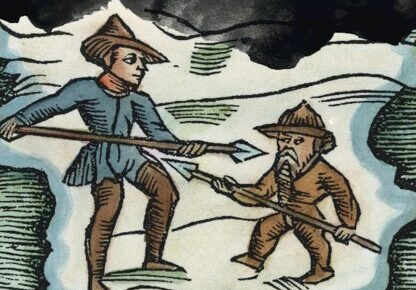
In Vikings: Valhalla, the drama television series created for Netflix, one of the central characters is Leif Eriksson, who comes from the outer fringes of the known world, along with other Norse Greenlanders. While the representations in the series may be fanciful, the existence of Norse inhabitants in Greenland is a historical fact. In the mid-980s CE, a settlement primarily consisting of farmers from Iceland was established in Greenland, and it lasted for more than 400 years. However, the loss of communication with Norse Greenland gave rise to a mystery that left a lasting historical, cultural, and literary impact on Western culture. This is the subject of my new book, The Vanished Settlers of Greenland: In Search of a Legend and Its Legacy.
The disappearance of the settlers is still not fully understood. A ship sailing from Greenland in 1410 is the last record we have of the Norse settlements. Archaeological evidence indicates that their society ceased to exist during the fifteenth century. In the centuries after contact with the northern land was discontinued, speculation about the settlers’ fate abounded. It was widely assumed that the larger Eastern Settlement might still be standing. Legends of this settlement’s wealth were repeated in European manuscripts and books, making Greenland an object of imperialist desire, similar to other lands in the New World.
Denmark had historical claims on Greenland but English explorers and Dutch whalers challenged those claims. During the seventeenth century, Danish historians sought to gain political leverage by intensely studying Greenland’s colonial history and the settlers’ use of the land. In the early eighteenth century, it was realised that historical references were not enough to keep away other European ships from fishing in Greenland waters and trading with the Inuit. At the same time, there was a growing missionary yearning to save the Christian colonists’ descendants, who were believed to live in isolation on Greenland’s ice-clogged east coast. The Dano-Norwegian missionary Hans Egede was granted royal permission to establish a colony on the west coast of Greenland in 1721. Documents from that time reveal that the hope was to re-establish contact with the Eastern Settlement and finance the mission through trade and the exploitation of its resources. Egede made two unsuccessful attempts at reaching the Eastern Settlement, but several Danish expeditions to the east coast, both by sea and over land, were launched in the 1720s. The expeditions were all failures, leading modern studies to view the fantasy about a still-standing Eastern Settlement as a wild goose chase. However, I argue in the book that it must be seen as an important driving force for Danish interest in Greenland during the early period of resettlement.
In the 1820s, after British and Danish expeditions had surveyed large portions of the east coast (finding no definite traces of surviving colonists), literary writers joined scientists and explorers in turning their attention to other parts of the Arctic as potential locations where the vanished Greenlanders might have emigrated. Many lost colony stories were published between 1870 and 1920, taking advantage of contemporary geophysical hypotheses suggesting that the North Pole had a temperate climate and an ice-free sea. These were adventure stories featuring either Norse migrants from Greenland or the descendants of bold Viking explorers found in secluded Arctic colonies.
These fictions about discovering a hidden Norse community were an imaginative extension of what was once a real ambition to recover the vanished settlers. Some British and American stories portray the degradation the settlers were imagined to have undergone while isolated in the wild, but others depict the fictional Norse settlers as having escaped the degenerative forces at play in the old world. The fascination with isolated colonies of strong, healthy, and physically impressive Norse warriors often reflected public anxieties about the detrimental effects of immigration and the decline of civilisation. The Arctic colonies thereby became communities frozen in time, serving as an antidote to the cultural and physical decline of modernity.
In the seventeenth century, Danish expeditions kidnapped several Inuit to bring them to Europe, but it could not be conclusively determined whether they were descendants of the Norse population. However, in the first part of the nineteenth century, the Italian impresario Signor Paganini travelled with an Inuit woman named Azil for several years, exhibiting her as a mixed-race individual. The theory that Norse colonists had intermarried with the Inuit to survive had already been proposed by Hans Egede and others. In this particular context, however, Paganini used Azil’s purported Nordic heritage to suggest that he had saved her from a Greenland that had fallen into barbarism.
During a 1912 expedition to Canada’s Victoria Island, the Canadian-born ethnologist Vilhjalmur Stefansson encountered a community that he believed, based on their head shape and facial proportions, were descendants of the Norse. Stefansson did not claim that they had fair hair; however, an enthusiastic world press coined the term ‘blond Eskimos’. Modern DNA analyses have since shown that the people of Victoria Island do not have Nordic genes. Nonetheless, in the early 20th century, Stefansson’s alleged discovery revitalised the old theories about a continued Norse presence in Greenland with a new pseudo-scientific perspective. This is just one late example of how references to Nordic settlers would survive, even centuries after their actual disappearance from Greenland’s fjords.
Latest Comments
Have your say!